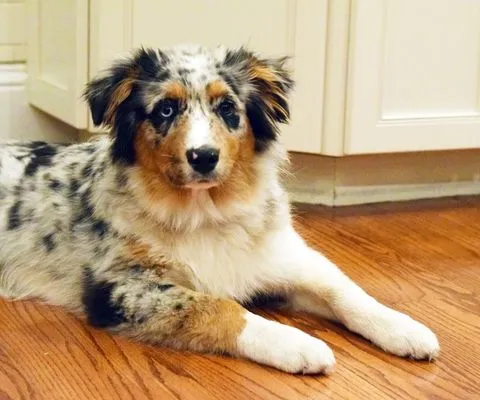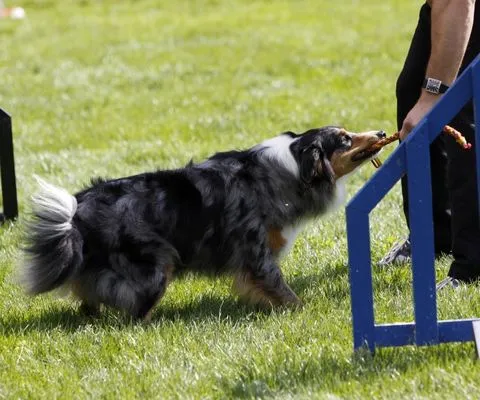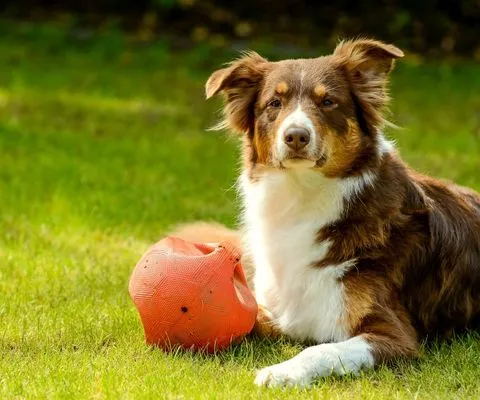Stages of an Australian Shepherd’s Coat: From Newborn to Senior
For an Australian shepherd dog, the coat comes in three basic types: Standard, Miniature, and Toy. These different types have different coat lengths and sheds at different times of the year, which can be confusing to new owners who are trying to care for their pet’s coats properly.
To help you understand your dog’s coat and how to take care of it, we’ve created this guide on the stages of an Australian shepherd’s coat from the birth of a puppy all the way to their senior years.

Australian Shepherd Full Grow
Australian Shepherds are a medium-to-large dog breed. When they’re full-grown, they can weigh up to 40 pounds and stand 22 inches tall at the shoulder.
The average lifespan for an Australian Shepherd is between 12 and 15 years old. Their coats come in three main colors—red merle, blue merle, or red tri—and each color has its own unique patterning.
Merles have both black and white hair throughout their coat; tri-colored dogs have a mixture of red, black, and white; while blue merles have more black than white with occasional spots of blue on their body.
Each color has its own distinct pattern that will change as your Aussie ages. This guide will help you understand what those changes look like so you can care for your pup accordingly.
As puppies, Australian Shepherds typically have a long, thick undercoat that helps protect them from extreme temperatures during hot summers and cold winters.
That undercoat will eventually fade away once your puppy becomes a fully grown adult. However, shedding season is where it gets tricky because it means you’ll see some old hairs fall out alongside new growth.
Hormonal imbalances may also cause abnormal shedding patterns which can be normal for some adult dogs and abnormal for others.
So if your Aussie starts shedding heavily during the season but doesn’t shed all year round, talk to your vet about adjusting her diet or increasing her exercise routine until her hormones balance out again.
As your pup ages, his coat will begin to change in appearance. You’ll notice more gray hairs mixed in with his original colors as well as more spots on his face and body.
His face will become longer and he’ll start to develop wrinkles around his eyes, mouth, and forehead. If he was previously a merle color dog with black-and-white markings on his body, those markings might begin to turn blue over time as well.
While there are many different factors that contribute to how quickly your Aussie ages—like genetics, nutrition, health conditions, and lifestyle choices—you can help slow down the process by keeping him happy and healthy throughout life.

Australian Shepherd Old Age
While Australian shepherds are still capable of performing as working dogs or family pets into their golden years, they tend to show signs of old age first. Your senior Aussie might experience some loose skin and fur that can be hard to manage, especially if he’s getting up there in age.
Grooming is a top priority for older dogs with limited mobility. Dental care will also become more important as your dog ages; senior dogs should have dental examinations every six months.
Watch for any signs of trouble, such as bad breath or trouble eating and swallowing food—these can be indicators that your dog has painful teeth that need attention from a veterinarian immediately.
In addition to dental issues, arthritis and joint pain may cause problems for aging dogs. Make sure you’re giving your pooch plenty of love and gentle exercise throughout his life to help him remain comfortable as he gets older.
You’ll know it’s time to put down an elderly dog when it becomes clear that he doesn’t enjoy daily activities anymore or has physical issues keeping him from enjoying them.
If you suspect something is wrong with your pet, consult a vet right away so you can find out what’s going on and decide on treatment options together.
Australian Shepherd Coat Types
There are five major coat types for Australian shepherds and they include; 1) Longhaired, 2) Longhaired with docked tails, 3) Docked Tails, 4) Docked tails and smooth coats, and 5) Smooth.
The main differences between each coat type are largely cosmetic but will also vary in weather tolerance. For example, longhaired dogs tend to shed more than their short-haired counterparts and require more grooming maintenance (such as regular brushing).
In addition, there’s a difference in what you should expect from your dog depending on his or her coat type. Generally speaking, long-haired dogs need more exercise because they can overheat easily while short-haired breeds are better suited for colder climates since they have less protection from cold temperatures.
So, if you live in a climate that gets very hot during the summer months, then it might be best to go with a short-haired breed. If you live somewhere that has mild winters and hot summers then it might be best to go with a long-haired breed so that your dog doesn’t get too hot during the summer months.

Australian Shepherd Coat Care
What should you expect from your Aussie’s coat? How do you know if it needs trimming or needs to be shaved down? You’ll find all your answers in our guide!
Let’s start with what breeders call a puppy coat and go through each stage as they grow up. We’ll also talk about tools you can use to keep them looking great, like brushes and clippers. After reading our guide, you’ll be ready for any Australian shepherd coat care situation that comes your way.
Keep ’em clean: One of the best ways to keep your Australian shepherd’s hair healthy is to make sure he stays clean.
Daily brushing helps remove dirt and debris that can get caught in his fur while helping him shed dead hair naturally by stimulating blood flow. It also keeps loose hairs at bay so he doesn’t track anything into your house (and have fun trying to pick those up!).
Make sure he gets regular baths—as often as once a week—to keep his skin healthy and his coat shiny. When it comes time for bathing, don’t forget that shampoo specifically made for dogs is best; human shampoo contains ingredients harmful to their skin.
If you’re using a dog-specific product, you’ll want to dilute it with water before applying it to avoid irritating your pup’s eyes or other sensitive areas.
And if you notice any redness or irritation after washing him down, rinse thoroughly with cool water until he looks normal again. He may be uncomfortable for a few hours afterward but should feel better quickly. If not, check with your vet!
To shave or not to shave? That is indeed the question when it comes to grooming your Aussie. Some owners choose to leave their pups’ coats long all year round, others prefer shortcuts during warmer months and long coats during wintertime.
Whichever option you choose will depend on how much upkeep each requires and what kind of look you’re going for!